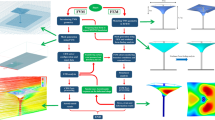Abstract
Computational Fluids Dynamics (CFD) tools guide engineers and designers to estimate the performance of new designs. However, a CFD analysis can be very time-consuming depending mainly on the grid size and domain complexity. Thus, this paper aims to describe the tools used to evaluate and compare the performance of different 3D draft tube models for reducing the time-effort needed in an optimization procedure. The results presented here, are the second part of an overall research to establish a global optimization methodology to improve the performance of an hydraulic draft tube through the inlet velocity profile. Previously, three steps of optimization methodology to minimize the energy losses were studied: the inlet velocity profile parameterization, the numerical optimization set-up and the objective function validation. In the latter step, a global optimization method called Multi Island Genetic Algorithm (MIGA) was considered, which requires a large number of iterations before producing a reliable result. This step is able to identify an efficient inlet velocity profile to minimize the energy losses through the draft tube model. However, each iteration is expensive in terms of computational time due to the need for 3D Navier–Stokes (NS) computations to evaluate each profile’s fitness. Thus, in this work the methodology attempts to accelerate the optimization process with accurate results. In order to achieve the goal, the grid size of the 3D draft tube model was minimized, resulting in a much lower computational cost. Specifically, the draft tube calculations were performed on a sequence of five different grids each having approximately twice the number of elements compared to the previous. The measurements of the sensitivity of the draft tube performance quantities to the change of the inlet velocity parameters during the process showed that, in spite of the numerical difference between its performance, the results have the same tendency. Consequently, the 3D draft tube numerical model with a minimal grid size, is reliable and left record of its capabilities for being integrated in the optimization process.
Similar content being viewed by others
References
Agouzoul M., Reggio M., Camarero R.: Calculation of turbulent flows in a hydraulic turbine draft tube. J. Fluids Eng. Trans. ASME 112, 257–263 (1990)
Andersson, U.: Test case T-some news results and updates since workshop 1. In: Proceedings of Turbine 99-WS2, the Second ERCOFTAC Workshop on Draft Tube Flow. Alvkarleby, Sweden (2001)
Bergström, J.: Turbulence modelling and numerical accuracy for the simulation of the flow field in a curved channel. In: ASME Fluids Engineering Division Summer Meeting, 22–26 June, FEDSM97-3298 (1997)
Bergström, J.: Approximations of numerical errors and boundary conditions in a draft tube. In: Proceedings of Turbine 99-Workshop on Draft Tube Flows. Porjus, Sweden (1999)
Bergström, J.: Modeling and Numerical Simulation of Hydro Power Flows. PhD thesis, Luleä University of Technology (2000)
Bergström J., Gebart R.: Estimation of numerical accuracy for the flow field in a draft tube. Int. J. Numer. Methods Heat Fluid Flow 9(4), 472–486 (1999)
Cervantes, M., Gustavsson, H.: Estimation of the radial velocity from the Squire–Long equation and experimental data. In: Water Power XIV: Advancing Technology for Sustainable Energy, Austin, TX, 14 (2005)
Engström, T., Gustavsson, L., Karlsson, R.: In: Proceedings of Turbine 99 Workshop 2 on Draft Tube Flow, Luleä University of Technology, Sweden (2001)
Fluent Inc.: Fluent 6.1 User’s Guide. Fluent Inc. (2003)
Galván, S.: Optimization of the Inlet Velocity Profile of the Turbine 99 Draft Tube. PhD thesis, École Polytechnique de Montréal (2007)
Galván, S., Page, M., Guibault, F., Reggio, M.: Numerical validation of different CFD k-e turbulent models using FLUENT code. In: Turbine-99 III, Proceedings of the Third IAHR/ERCOFTAC Workshop on the Draft Tube Flow, 8–9 Dec 2005, Porjus, Sweden, paper 4 (2005)
Galván S., Pacheco J., Rubio C., Mendoza C., Toledo M.: Optimization methodology assessment for the inlet velocity profile of a hydraulic turbine draft tube. Part I: computer optimization techniques. J. Glob. Optim. 52(3), 1–20 (2012)
Galván S., Reggio M., Guibault F.: Assessment study of k−ε turbulence models and near-wall modeling for steady state swirling flow analysis in draft tube using fluent. Eng. Appl. Comput. Fluid Mech. 5(4), 459–478 (2011)
Gebart, B., Gustavsson, L., Karlsson, R.: In: Proceedings of Turbine 99 Workshop 1 on Draft Tube Flow. Technical report 2000:1. Luleä University of Technology, Sweden (2000)
Lindgren, M.: Automatic Shape Optimization of Hydropower Flows: The Draf Tube. Master’s thesis, Luleä University of Technology, Luleå, Sweden (2002)
Marjavaara D., Lundström T.: Redesign of a sharp heel draft tube by a validated CFD-optimization. Int. J. Numer. Methods Fluids 50, 911–924 (2005)
Puente, L., Reggio, M., Guibault, F.: Automatic shape optimization of a hydraulic turbine draft tube. In: CFD 2003: The Eleventh Annual Conference of the CFD Society of Canada, Vancouver, BC (2003)
Ruprecht, A., Eisinger, R., Göde, E.: Innovative design environments for hydro turbine components. In: HYDRO 2000, Bern, v2000-05 (2000)
Shyy W., Braaten M.: Three-dimensional analysis of the flow in a curved hydraulic turbine draft tube. Int. J. Numer. Methods Fluids 6, 861–882 (1986)
Song, C., He, J., CHen, X.: Calculation of turbulent flow through a Francis turbine runner and elbow draft tube. In: International Power Generation Conference, San Diego, CA, USA, pp. 1–6 (1991)
Author information
Authors and Affiliations
Corresponding author
Rights and permissions
About this article
Cite this article
Sergio, G., Carlos, R., Pacheco, J. et al. Optimization methodology assessment for the inlet velocity profile of a hydraulic turbine draft tube: part II—performance evaluation of draft tube model. J Glob Optim 55, 729–749 (2013). https://doi.org/10.1007/s10898-012-0011-4
Received:
Accepted:
Published:
Issue Date:
DOI: https://doi.org/10.1007/s10898-012-0011-4




